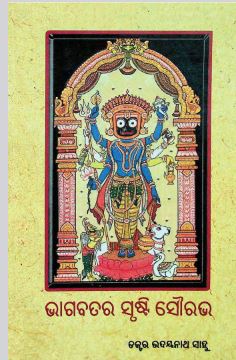Bhagabatara Srusti Sourabh by Uday Nath Sahu, published in 2009, stands as a seminal work in Odia literary criticism. Drawing upon the rich cultural and spiritual ethos of Odisha, the book meticulously explores the nuances of the famed “Bhagabat” written by the revered Odia saint-poet, Jagannath Das. Through a series of insightful essays, Uday Nath Sahu not only pays homage to the timeless epic but also delves into its profound philosophical and literary significance, which resonates deeply within the Odia community and beyond.
One of the standout features of “Bhagabatara Srusti Sourabh” is Sahu’s ability to dissect and discuss each sub-essay with scholarly precision and yet convey it in a manner that is accessible to a broader audience. The book is carefully structured to lead readers through the historical context, the poetic mastery, and the spiritual dimensions of Jagannath Das’s seminal work.
Jagannath Das, born in the 15th century, rendered the “Bhagabat” in Odia, transforming an ancient Sanskrit text into a resonant spiritual guide for the common people of Odisha. This work is not merely a translation but an enriched, localized adaptation that incorporates the linguistic and cultural contexts of the region. Sahu’s essays illuminate how Jagannath Das’s “Bhagabat” transcends mere religious scripture, emerging as a cornerstone of Odia literary heritage and a beacon of moral and ethical teachings.
Sahu’s exploration is multi-faceted. One notable essay within the book discusses the thematic essence of the “Bhagabat,” highlighting its underpinnings of Bhakti (devotion) and its reflective contemplation on human morality, devotion, and the pursuit of knowledge. The author deliberates on how Jagannath Das, through his eloquent verses and philosophical depth, advocates for a society grounded in righteousness and compassion.
Another critical aspect of Sahu’s work is his discussion on the literary devices employed by Jagannath Das. He examines the poet’s use of metaphor, simile, allusion, and rhythmic cadence, which not only enrich the narrative but also enhance its didactic impact. Sahu’s keen insights into these stylistic elements offer readers an appreciation of the “Bhagabat” as a literary masterpiece apart from its spiritual gravitas.
Sahu also delves into the broader cultural implications of the “Bhagabat.” He discusses its role in the daily lives of the people of Odisha, its influence on local customs, music, dance forms, and even festivals. The “Bhagabat” is portrayed as a living document that continues to shape and inspire Odia collective consciousness.
The inclusion of contextual analyses and comparative studies with other regional literatures and scriptures further underscores the comprehensive nature of Sahu’s scholarship. His ability to weave together historical context, literary critique, and cultural commentary makes “Bhagabatara Srusti Sourabh” an indispensable resource for students, scholars, and aficionados of Odia literature.
In conclusion, “Bhagabatara Srusti Sourabh” by Uday Nath Sahu is a profound tribute to Jagannath Das’s epic, the “Bhagabat.” Published in 2009, the book serves as a beacon of knowledge, presenting its readers with an insightful exploration of one of Odisha’s greatest literary treasures. Through his scholarly yet accessible essays, Sahu has ensured that the spiritual and literary essence of the “Bhagabat” continues to inspire and guide future generations. This book is indeed a celebration of Jagannath Das’s enduring legacy and a testament to the rich cultural tapestry of Odia literature.
Books Info
| Books name | Bhagabatara Srusti Sourabh/ଭାଗବତର ସୃଷ୍ଟି ସୌରଭ |
| Author | Uday Nath Sahu |
| No Of pages | 153 |
| Publisher | Athena Books |
| Publication | 2009 |
| Printed At | Athena Books |
| Distributor | NA |

